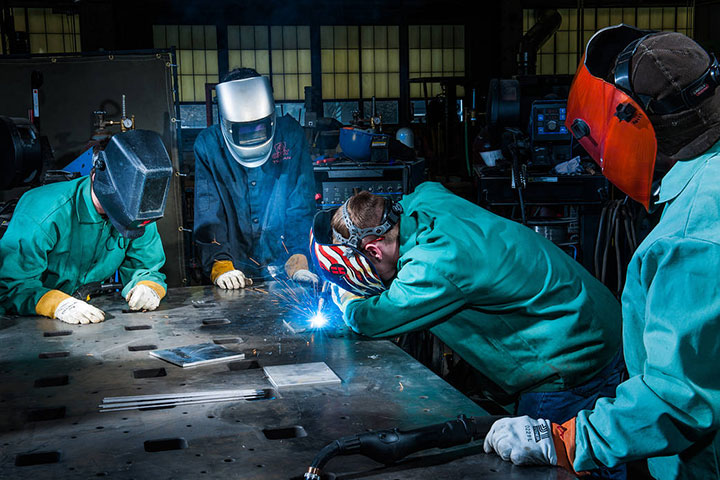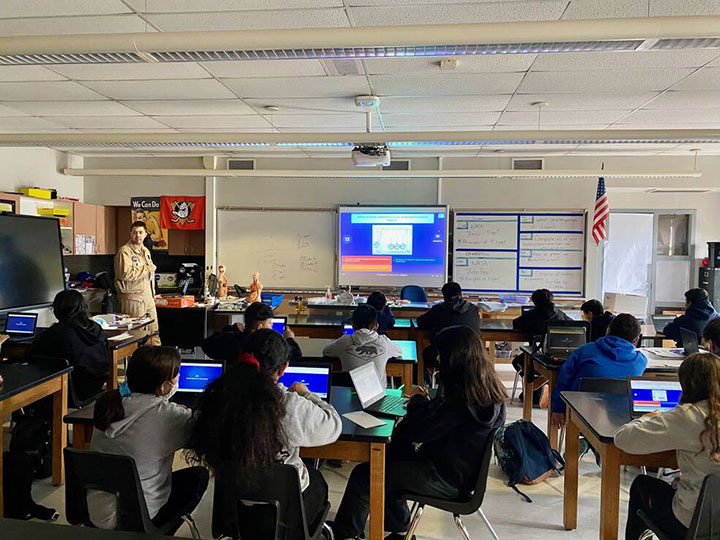
ALEXANDRIA, Va. — There might not be “Help Wanted” signs on the doors, but the employment pages across commercial space companies show just how much demand and competition exist for various skills in a growing industry.
A search of the popular job site ZipRecruiter.com earlier this year turned up more than 91,000 U.S. openings for aerospace engineers, according to a recent Space Report. In Colorado Springs, a space industry hub with a population of about a half million, the number of openings exceeded 5,800.
The demand for workers in a growing space economy extends beyond engineers or program managers. According to a recent blog post by EVONA, an international recruiting firm for the space sector, the skillsets companies are hiring for at the fastest rate were non-technical. Companies saw the fastest rate of growth in need for the operations professionals, such as management, accounting, human resources, inventory and others. The next fastest-growing areas were Python, agile methodologies, laboratory skills and analytical skills.
To help address the demands of a growing space economy, EVONA has been working with space employers worldwide to do a sort of skillset matchmaking. “More often than not, that actually includes recruiting from outside the space sector,” explained EVONA CEO Tom Kelly. “We’re acutely aware of the fact there’s so much growth in the sector and not enough people with relevant skills within the sector.”
Rather than create a bidding war between space tech companies, employers are increasingly open to the alternative approach of evolving relevant skillsets into the sector. Companies have had success bringing in electrical engineers, account executives and cybersecurity professionals from outside the space sector. Kelly noted that flight software engineers have become a “poster boy” example of professionals that can be recruited outside the industry and cited a case study where a company hired engineers from the automotive sector. “It was the exact same skillset and people with no preconceived ideas of how to do this were able to outperform others,” he said.
Some skills are not transferable, he continued. Program managers and systems engineers are among the positions that employers will keep open for months at a time waiting for a candidate with the right experience in the space sector.
With the global commercial space economy growing at 8% year-on-year and more companies looking to scale operations, there is real recognition of just how tight the labor market is. Additionally, even as companies seek talent outside the sector, they are finding stiff competition with other industries. There are opportunities to solve this challenge in the short term with recruitment support, apprenticeships and programs focused on upskilling and reskilling workers. In the long term, the space workforce is not getting any younger and both industry and governments have a role to play in cultivating, inspiring and preparing the next generation of talent.
Competing with Silicon Valley…and Detroit
In its Q1 2023 Space Report, the Space Foundation documented an ongoing decline in the number of U.S. STEM (science, technology, engineering, math) undergraduates. Today, nearly 90,000 fewer college students are majoring in STEM fields compared to 2017. There are also fewer students completing two-year trades programs or certifications in critical space-related occupations.
These education trends are not true worldwide. According to UNESCO statistics, Malaysia, Tunisia, the UAE, Germany, Belarus, India, South Korea (and likely China), all have more than 30% of university students graduating with STEM degrees.
The U.S. space industry is “especially sensitive” to kinks in the talent pipeline resulting from fewer STEM graduates, explained Tom Roeder, a senior data analyst at the Space Foundation. Part of that is because vendors with U.S. government contracts are subject to stricter hiring practices, including security clearance and U.S. citizenship, which can dissuade otherwise qualified workers. “You don’t need that in Silicon Valley. You don’t need that in Detroit. But in the space industry, you darn well need that,” Roeder said. He noted that space companies in Europe that are not subject to the same conditions have been able to mitigate labor shortages with foreign-born workers.
Additionally, the space industry is charting an expansion path at the same time other U.S. industries are reviving manufacturing. “We haven’t seen demand in manufacturing like we’ve seen lately,” Roeder said. “Everybody’s trying to scale up at the same time. And everybody is trying to hire the same type of workforce.”
 Numerous U.S. industries are on-shoring manufacturing and elevating demand for skilled workers. A senior welder and engineering technician gives a tutorial to college students at NASA Glenn Research center. (Source: NASA)
Numerous U.S. industries are on-shoring manufacturing and elevating demand for skilled workers. A senior welder and engineering technician gives a tutorial to college students at NASA Glenn Research center. (Source: NASA)
Electricians, welders, solderers, steelworkers, concrete workers are all in high demand for space and non-space. Automation may have phased out some positions, but there is an ongoing need for human workers in positions like operating, repairing and manufacturing pick and place robots and being the human in the loop for AI systems.
However, some of the toughest competition is for embedded software, electrical engineering and RF-skilled talent, which is in high demand across numerous sectors. “Anything to do with those hardware activity-related positions is brutal,” Kelly said.
Satellite companies are seeing a shortage of available FPGA (field programmable gate array) engineers amid growing demand in the financial services sector to support low-latency, high-frequency trading. “Fintech hired all those people and they paid them a fortune. So, everyone then has their head turned and in an innovative space funded by venture [capital], they just can’t compete,” Kelly explained.
There is also fierce competition for cybersecurity and DevSecOps professionals across industries and around the globe. In 2022, the cybersecurity professional organization (ISC)2 reported the gap in cybersecurity professionals worldwide grew more than twice as fast as the workforce, representing an estimated 3.4 million open positions. Filling that gap is a daunting challenge that has captured the attention of governments and private industry seeking to address demand through education initiatives and incentives.
Money Talks, Culture Counts
Salaries and job security always impact a company’s ability to attract and retain talent in a competitive market. In the U.S. private space sector, the average salary was $126,695 at the end of 2022, nearly twice the average pay in the private sector and well above the average pay for all STEM jobs. Salaries have continued to increase in 2023, according to EVONA, even with economic headwinds. While salary is often a top motivator for employees, it’s not the only one. Culture also plays a role.
Over the last several years, the Space Foundation has documented a slight drop in the number of computer scientists moving into space fields. Roeder attributed that to high demand across industries, the risk associated with space ventures, but also company culture. “Would you rather hang out in a cool office with beer on tap, video games all around the place and beanbag chairs? Or would you want to work in a place where you should really wear a tie every day and need security clearance?” he noted. “That’s going to be an issue you run into with the software folks.”
Beyond lavish office perks, there has also been a trend toward employees gravitating toward work that is meaningful and serves a purpose—this is particularly true of millennials and younger workers. This is an area where space companies have a unique advantage. A post-pandemic study by McKinsey & Co. found 70% of employees are seeking purpose through their work. Other studies have confirmed the importance of meaningful work in retaining talent.
“I think there are lots of students interested in working in the space industry because the cultures have changed now to be less focused on earning money and more focused on having a purpose. Of course, the space industry serves a great purpose,” said Kelly.
The Future Workforce
Despite rising inflation, tight capital markets, banking instability and an estimated 160,000 layoffs in U.S. tech companies this year, the STEM labor market has remained frustratingly tight. There are immediate opportunities to expand the space workforce by transferring talent and skills. But much of the focus is on preparing the next generation.
 NASA Armstrong’s Operations Engineer, Joe C. Piotrowski leads students at Mendez Fundamental Intermediate School in Santa Ana, California during a lesson in aeronautics at the June 2023 Aero Fair. (Source: NASA/Cassandra Cabrera/ Mendez Fundamental Intermediate School)
NASA Armstrong’s Operations Engineer, Joe C. Piotrowski leads students at Mendez Fundamental Intermediate School in Santa Ana, California during a lesson in aeronautics at the June 2023 Aero Fair. (Source: NASA/Cassandra Cabrera/ Mendez Fundamental Intermediate School)
“Right now, in the United States, the bulk of your aerospace workforce can get a senior discount at Denny’s,” said Roeder, noting the average aerospace engineer is approaching their 45th birthday. It’s a troubling situation, especially when combined with a decline in U.S. STEM graduates and primary school math scores dropping to their lowest level since the 1970s.
“The Space Foundation itself is really trying to address that problem in the U.S. and globally by putting space in the classroom earlier,” Roeder said. “What we’re finding, honestly, is first grade might be too late. The younger you have exposure to the concepts of space, the better the outcome is at the other end of the spectrum in terms of life choices and career choices.”
Industry has a part to play in engaging with organizations, government programs, school districts and educational institutions to expose the next generation to space and space technology. There are also opportunities to inspire students to pursue areas where they can have a big impact and a promising career path.
“We’re doing our best to speak to every university, every school, every kid,” Kelly said. The message is, “If you want to have a real purpose and be in an area where you’re in huge demand, you should study electrical engineering because that’s massive.”
Explore More:
Podcast: Accessibility, Demand for Commercial Space and America’s Tech Workforce
Space Force Taps Universities for 5 Areas of Collaboration
What Happens When You Triple On-Orbit Capacity?
University Spotlight: A Systems Engineering Approach for Emerging Space Actors
